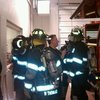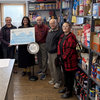Archives to be saved with library
VOORHEESVILLE — The Voorheesville Public Library’s archivist, James Corsaro, is working to preserve village records by placing them in the state’s library data system.
“Villages like this usually don’t get involved in this type of thing,” Corsaro said. Voorheesville, he said, is one of a handful of small municipalities across the state adding their record catalogs to the state system.
He and library director Gail Alter Sacco have joined village historian Dennis Sullivan in a project to archive and preserve long-collected local records that represent Voorheesville’s past.
“It’s a collaboration between the village of Voorheesville, the library, and village [organizations] to preserve their records and increase opportunity for the public to have access to them,” Sacco said.
“The village historical records we have on deposit from the village of Voorheesville — that is, on long-term loan; the village still is the owner of the records — are not the everyday, current official records of the town…which are still kept by the village clerk,” Corsaro said. “Basically, we have either privately-created records like the Odd Fellows, volunteer fire department, and family records; or a few very old village government records, which have historical value, but no current legal value,” he said.
Over the past five months, Corsaro pored over 40 boxes of materials and sorted them into categories, with labels like the Voorheesville Fire Department or the Odd Fellows hall. He then described what was in each group of records, which included photographs and a lot of documents, he said. In Voorheesville, for example, many of the records are related to grade crossings, or where a railroad crossed a highway, which sometimes held controversy, Corsaro said.
Corsaro credits Sullivan for spending 30 years collecting photographs of Voorheesville.
“The photographs part of the records is really important,” Corsaro said. “Our purpose is to make them available to the public.”
The compilation includes photos of local people and events, but, still to be found in the collection, are pictures taken in the mid-1990s, Sullivan said.
Former Mayor Edward Clark and former Trustee Susan Rockmore were history enthusiasts, Sullivan said.
“They gave me a good budget every year. If I saw something that was $100 to $200, they would say, ‘Get it,’ ” Sullivan said. At that time, Sullivan used the historian’s budget to document village structures.
“I hired a photographer and he took a picture of every building in Voorheesville,” Sullivan said. The 4-by-6-inch photos made up a six-inch-thick stack, but the stack is lost in the collection, he said.
Sullivan said that the village’s records also include physical artifacts from Voorheesville’s past, like cigar boxes from the former Hallenbeck cigar factory on Main Street, wooden molds from the closed foundry, and cider bottles from the defunct Mott’s juice factory.
“The wonderful…Roger Keenholts, Guilderland town historian, would share. He always found good stuff and passed it on. Not just on my own efforts, but in collaboration with Roger, I found a one of a kind book,” Sullivan said.
The book was written by the owner of property on Font Grove Road, and dates to the early 20th Century, when three copies of the book were made, he said.
“You can see that it was done with carbons. The typeface is that sort of blue you would see on carbons,” he said. The book he found was a copy, and not the original, he said; in addition to the blue type, photos had been pasted in.
“That is a rare piece of work,” Sullivan said.
“There is a deed that goes back to the early 18th Century signed by LaGrange and Veeder. We have those kinds of documents,” he said.
“There are diaries in there, diaries of farmers in the Voorheesville area,” he said of the collection, noting that one of them was written by Derek Raynsford, who owned the old house that until the last decade stood at the corner of routes 85 and 85A.
The diary was written in light pencil, Sullivan said.
“Jim transcribed that diary already,” he said of Corsaro. “You get a sense of what a farmer’s life was like in 1880 — how he spent his money, who came over. The social life of the town of New Scotland at the time.”
Sullivan, a columnist for The Enterprise, said, “I read every edition on microfilm of our esteemed and venerable paper.” He took notes of the social lives documented in Voorheesville in the paper since 1884 and included them in the library collection.
Researchers can now find who framed houses or painted them, he said.
“We know the progression of the houses in Voorheesville — where churches were to be built, and why, and where they actually were built,” Sullivan said. About reading a century of papers, he said, “It was a labor of love, fleshing out the lives of these people in wonderful ways.”
The project
Sacco said that the library is the only public building in the village that is air-conditioned — an important factor in keeping old paper records from deteriorating due to swings in temperature and humidity.
“We are the best-equipped to preserve them for the long haul,” Sacco said.
“Jim is a master archivist,” Sacco said of Corsaro, who retired as an associate librarian for the New York State Library. “He’s helping us become more organized and focused,” she said.
Corsaro plans to complete the catalog of Voorheesville’s records in the next month. He will send the catalog listing the materials in Voorheesville’s collection to the State Library, and the State Library will upload the catalog to Excelsior, the state’s online archive, he said.
“The material doesn’t circulate. Like all archival material, it has to be used in the library,” he said. The online archive will tell researchers which records, now being listed and described by Corsaro, are available in Voorheesville.
The physical records will remain in the village, he said, but each may be digitalized in the future.
“We hope to do that, eventually,” he said. For now, pictures within the materials are kept in photographic sleeves that preserve photos and keep them from fading.
“People can handle the photos without endangering them,” Corsaro said. His project lists the photos so that researchers can find them.
Sacco said that the project will help people doing genealogy or other research through the Excelsior catalog to see that Voorheesville has the records.
Record keeping
Libraries become hubs for local history and genealogical research, Sacco said. The library allows users access to ancestry.com at no charge, which is “a real asset,” Sacco said, “Ancestry.com is quite pricey for people to buy.”
Recently, the library has made available recordings of oral histories of local residents, Sacco said. Some of the recordings are available on the library website, voorheesvillelibrary.org
“It’s a gift to be able to have that stuff,” Sacco said. “It’s a gift to be able to hear them.”
When Sacco’s mother was ill, she said, “I taped her. It’s a good project to do with a shut-in,” she said. Her mother was resistant until Sacco told her, “Your great-grandchildren can hear your voice. She was in!” Sacco said.
Sullivan gathered similar recordings in Clark and Rockmore’s era, using his budget to hire a Voorheesville high school student to tape interviews with elderly village residents.
“We have those interviews on tape,” Sullivan said. “They were talking to me about what happened in Voorheesville in 1915. Those DVDs are now at the library, as well.”
Sullivan said that Sacco, in her advisory capacity, wanted the library to be a repository for village artifacts, so that documents would be made available to people in the community.
“Gail has been very insightful in that regard,” he said. “Now, we have the Babe Ruth of manuscripts working with us, in Jim Corsaro. He indexed and catalogued New Scotland Historical Association records. What he gets done in a short period of time! Jim Corsaro is a magician.”
Sullivan said that Corsaro’s work has made pictures, documents, and objects from Voorheesville’s past available to the community.
“That makes this project 100-percent valuable for everyone,” Sullivan said.


